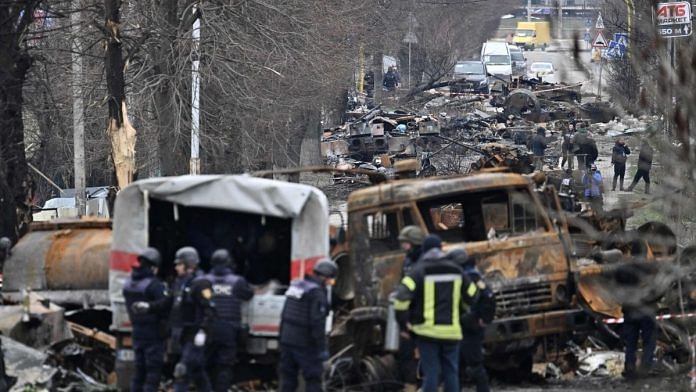
New Delhi: Addressing the media in a bullet-proof vest from Bucha earlier this week, Ukraine President Volodymyr Zelenskyy described Russia’s atrocities in the city and the rest of his country as a “genocide”.
After Russia retreated from Kyiv, multiple reports claimed that bodies were found strewn across the capital region, specifically Bucha, a suburb 30 kilometres from Kyiv.
Ukraine started war-crime investigations against Russia after finding 410 bodies across the capital region. The International Criminal Court at The Hague had last month also launched a probe into war crimes, allegations of crime against humanity, and genocide in Ukraine.
However, Russia’s Foreign Minister Sergei Lavrov claimed that the Bucha accusations were an “act” staged by Ukrainian forces to deter the peace talks. Meanwhile, Reuters reported that satellite imagery from a private US-based company, Maxar Technologies, has shown that the bodies had been lying in Bucha weeks before Russia’s retreat.
India has also described the events as “disturbing” and asked for an independent inquiry into the killings.
ThePrint explains how ‘genocide’ is defined by international law.
Also read: Did Ukraine helicopters strike Russian oil depot? Moscow points finger but Kyiv denies role
What is genocide?
While investigations to determine a genocide take time to conclude, there exists a consensus in international law on ‘what is genocide’ and ‘when it can be declared’.
Genocide was classified as an international crime by the United Nations General Assembly in 1946. It was later demarcated as an independent crime by the 1948 Convention on the Prevention and Punishment of the Crime of Genocide, commonly referred to as the Genocide Convention.
The International Court of Justice (ICJ) has also stated that principles of the convention are primary facets of international law. This means that all states must accept genocide as a crime to be prevented under international law, even if some states are not signatories of the Genocide Convention. As of January 2018, the Genocide Convention has been recognised by 149 states.
According to the convention, acts carried out with the intent to destroy — completely or partially — a race, ethnicity, nationality, or religion, is genocide. The convention lists partial killing, inflicting physical or mental harm, undertaking measures to prevent birth, or forcibly transferring children of the group to another as acts that constitute genocide.
Alexander Hinton, director of the Center for the Study of Genocide and Human Rights at Rutgers University, told Politico that those who inflict genocide “want to destroy a people as opposed to defeating an army”.
In essence, the convention includes both physical and mental harm as the bases for determining a genocide. However, the difficulty lies in proving the “intent” that exists in declaring genocide. In practice, existing state policies or plans must exist to depict the deliberate killing or targeting of a group.
While Putin’s statements to “de-Nazify” Ukraine reflect “intent”, it is unclear whether it has resonated with Russia’s bureaucracy and army. There is also no proof of a systemised Russian plan or policy to commit genocide in Ukraine. Thus, proving a genocide in Ukraine will require more time, proof, and legal nuance.
Armenians, Holocaust & Rwanda
While critics argue that the narrow definition of the genocide convention has led to its minimal application to mass killings, there exists consensus on three atrocities as genocide.
First is the mass killing of Armenians by the Ottoman Turks between 1915 and 1920. Estimates suggest that nearly 1.5 million Armenians were killed during the early stages of World War I within territories of the Ottoman Empire.
The second is the Holocaust between 1933 and 1945 by the Nazi regime in Germany, which led to the deaths of more than six million Jews.
The third is the 1994 Rwanda killings, when the minority Tutsi tribe were targeted by the majority Hutu tribe. The Hutu government and associated militias killed between 800,000 and 1,000,000 Tutsis.
Estimates suggest that 100,000 Hutus were also killed. These killings included Hutu extremists killing Hutu moderates and Tutsis killing Hutus as revenge.
Also read: Status of Ukraine war: Donbas now Russia’s priority, troops retreat from Kyiv & Chernihiv

COMMENTS